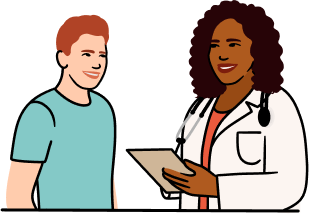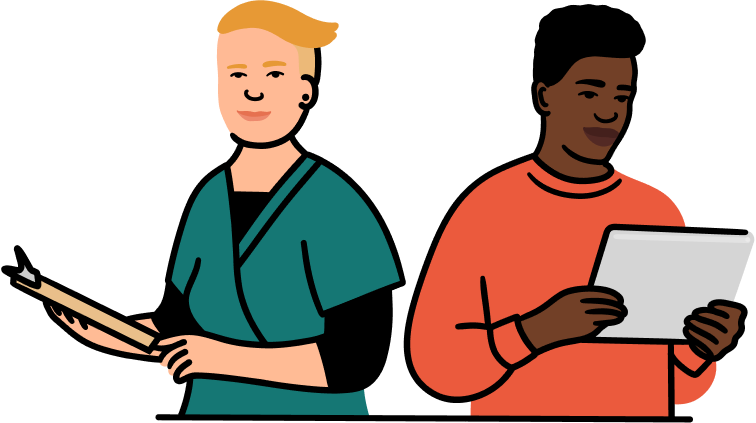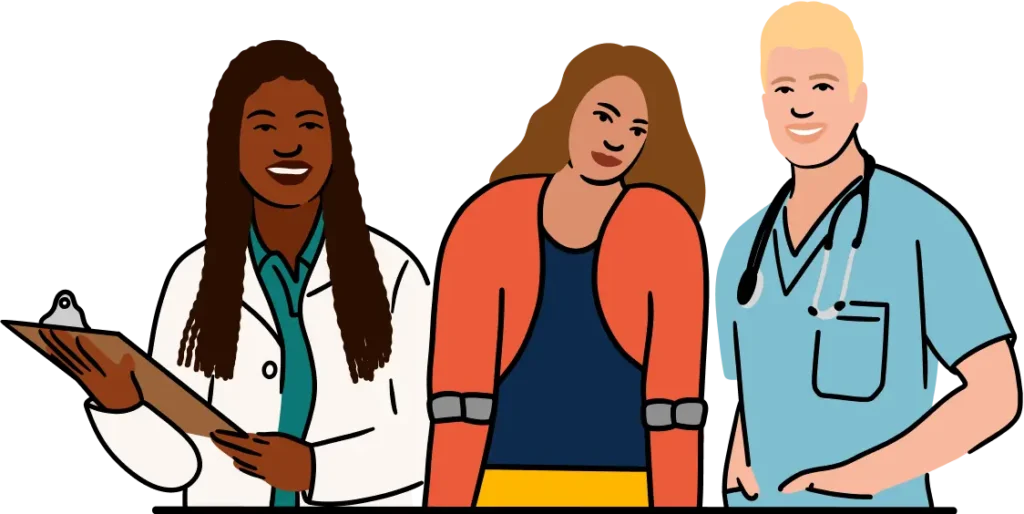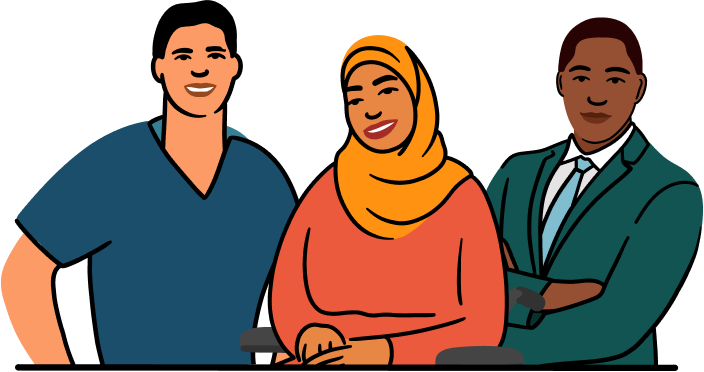Resources
Principles for authentic community engagement
The path to better health outcomes starts by valuing the IDD community’s expertise. This tool outlines six principles of authentic community engagement, provides examples of how the principles work in practice, and offers practical strategies for scaling.
About the principles
Building a healthcare system that meets the needs of community members requires a commitment to engaging people in ways that are genuine, meaningful, and build trust by leading to action based on their input. Such “authentic engagement” serves as a critical foundation for designing care models, clinical research, policies, and programs that aim to improve the well-being of any community.
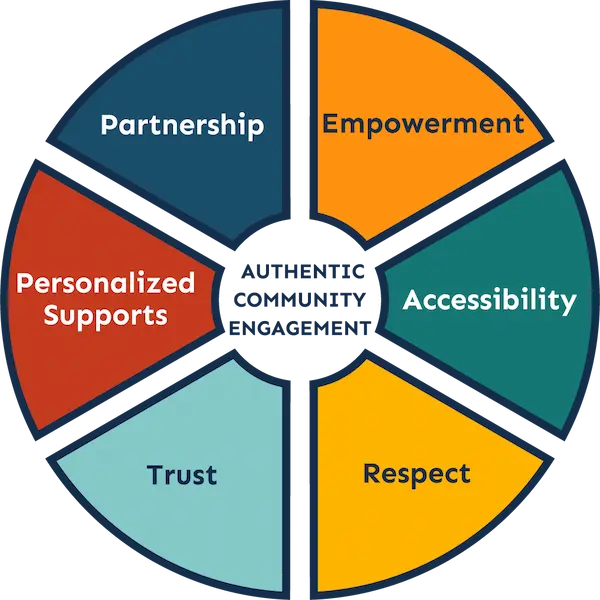
Principles of authentic community engagment
We organized these principles into six distinct domains, as outlined below, and provided examples of how the principles worked in practice at a 2023 summit. Click to expand each.
Partnership
- Establish group norms that are read aloud at the start of each meeting as a reminder of specific ways to foster partnership and respect for people with IDD (PWIDD).
- Use icebreakers to encourage relationship-building and commonality across stakeholder members.
- Flatten hierarchies by avoiding using professional titles or degrees and encouraging participants to refer to each other by first names.
- Practice multi-lateral empathy by encouraging all stakeholders to share their own perspectives and hear those of others.
- Foster shared learning and collective decision-making to promote “power with” instead of “power over.”
- Value all expertise, especially the genius of lived experience, by finding creative paths to incorporating stakeholder input.
- Ensure accessibility for all participants by avoiding jargon and acronyms, using plain language, and providing accommodations for differences in communication preferences and other sensitivities, such as use of video or intolerance for loud noises.
What Partnership Looks Like
Bringing people with lived experience (self-advocates) and healthcare leaders, payers, and clinicians to the table together presents distinct challenges. One pivotal strategy we employed was establishing group values and guidelines in collaboration with self-advocates. These norms are essentially practical reminders for how all participants should promote inclusivity so that everyone – particularly people with lived experience – can hear and be heard. Examples include, “speak slowly and in plain language” and “give each other time to think and answer.” These standards were read aloud, often by self-advocates, at the start of every meeting. Participants actively upheld them during meetings. If a participant strayed from these values and guidelines, we politely and privately messaged the individual, urging them to pause, re-frame, or ask for feedback and, if needed, followed up with individual calls to reinforce the values.
Empowerment
- Elevate PWIDD as experts and explicitly seek their input.
- Find opportunities to support individual community members in building their unique skills and confidence.
- Acknowledge questions – whether they are repeating previous discussions or raising challenging issues – and seek the opinions of all participants in conversations.
- Practice patience and allow people time to process information, consider options, form opinions, and share perspectives.
- Request input from PWIDD on all decisions and thank them for sharing their expertise and perspective. • Include PWIDD from the start of each phase of the project to co-design and co-plan core aspects of the work.
What Empowerment Looks Like
When all stakeholders play a role in the co-design, planning, and implementation of a project, it is more likely to meet its goals. In keeping with this philosophy, we established a Core Team and an Advisory Council. Both included equal numbers of members from each of the key stakeholder groups. The Core Team included one member from each stakeholder group and met monthly, supporting Project Leads with major project decisions and providing feedback on all matters. This regular collaboration ensures that the diverse perspectives and expertise of all stakeholders are integrated into project decision-making. The Advisory Council included several representatives from each stakeholder group and provided essential guidance, including on project deliverables.
Accessibility
- Identify everyone’s communication and accommodation preferences proactively to support full inclusion.
- Welcome all preferred methods of communication and create space in meetings to amplify perspectives that are shared by chat or Augmentative and Alternative Communication (AAC) devices.
- Create accessible electronic resources and materials using plain language, photos, or other graphics with alt-text, and text-to-speech features, ensuring compatibility with screen readers.
- Ensure that in-person meeting spaces are wheelchair-accessible, accommodate sensory sensitivities, and provide other disability-related accommodations.
- Invite PWIDD to include their support person in meetings, prep calls, and project-related travel.
- Include a graphic facilitator to assist team members with understanding the prioritized health outcome domains, definitions, elements, and goals.
What Accessibility Looks Like
To ensure that our in-person meeting would be fully accessible to all, we took a proactive and collaborative approach. For example, attendees who use wheelchairs educated us that ADA compliance does not always mean full accessibility. To address this, we started out by requesting their wheelchair measurements. When we visited potential meeting sites to assess the space, we measured doorway clearances and hallway widths to be sure that two wheelchairs could pass comfortably. Additionally, we verified that bathrooms and meeting rooms had adequate space for maneuvering a wheelchair. We also invited a local partner with lived experience of IDD to join the site visits and offer his expert perspective.
Respect
- Integrate core disability values at all levels: self-determination, civil rights, dignity, and community inclusion.
- Presume ability/competence of individuals.
- Describe people’s capabilities or support needs rather than describing a level of functioning or “severity” of IDD.
- Promote the social model of disability over the medical model of disability.
- Learn each person’s preferred name, pronouns, and ways of interacting with others (for example, if they prefer to approach others first rather than be approached).
- Encourage using language that respects individuals’ preferences regarding how they’re identified in relation to their disability. This includes using identity-first language (like “autistic adults”) or person-first language (such as “person with Down syndrome”), unless someone prefers a different term. Use “non-speaking” instead of “non-verbal.” It’s important to learn and honor individual language preferences, as generalizing based on group perspectives may not be appreciated or considered respectful by those with differing perspectives.
- See individuals as a person first. Be curious and authentically interested in the personal stories and interests that define who they are.
- Listen deeply with intention; pause for questions, comments, and requests for clarity; and check frequently for understanding.
- Promote diversity by making a special effort to include individuals from diverse backgrounds, such as people of color, queer identities, and those with varying IDD diagnoses, support needs, geographical locations, genders, and ages.
- Pay PWIDD equitably and fairly for their expertise (no less than $50/hr and higher if they take on leadership roles):
- Learn guardianship status to determine the appropriate signatory on forms and where payments should be sent or deposited.
- Accommodate any income ceilings due to restrictions in public benefits.
- Offer choices for payment, such as cash or a gift card.
- Include care partner/giver/rep payee on communications about payment, if preferred.
- Track hours spent on meetings, prep calls, and asynchronous preparation, and prepare draft invoices for PWIDD to review, sign, and submit.
What Respect Looks Like
At the beginning of our meetings, we consistently reviewed values and guidelines, emphasizing the importance of respecting everyone’s preferences when it comes to how they’re identified in relation to their disability. We collectively acknowledged the diverse perspectives – for example, that some individuals prefer person-first language, while others prefer identity-first language.
At a recent multi-stakeholder meeting, one of our self-advocate partners volunteered to elaborate on this topic. We invited them to the podium to share their personal perspective and insights. Using themself as an example, they emphasized the complexity of identity, highlighting the need to avoid categorical labels. They self-identified as a non-binary, autistic person with an intellectual disability, emphasizing that many people have multiple identities, and we should steer clear of rigid labels. The 50 individuals present in the room showed their appreciation with a standing ovation, reinforcing the group’s respect not only for what they shared but also for them as an expert.
Trust
- Foster a culture of belonging and community.
- Recognize the trauma, stigma, and bias that most PWIDD often face in the healthcare system and living in this society.
- Practice cultural humility. Strive for self-awareness and recognition of one’s own implicit biases.
- Express empathy, not pity.
- Shift the paradigm to following community members rather than leading them.
- Follow through on commitments in response to PWIDD’s input in a timely manner.
- Be self-reflective; acknowledge our mistakes and apologize as necessary.
- Gather input and feedback from PWIDD to help improve our individual and team performance.
What Trust Looks Like
We conducted one-to-one sessions with each self-advocate participant to learn their personal health stories, what good and bad health looks like for them, and what matters most to them about their health. Nearly all shared that they experienced stigma, bias, and trauma in many healthcare encounters. Most told us that they rarely felt truly heard. Many shared that the opportunity to articulate their stories in IIDDEAL was deeply meaningful to them and helped to rebuild trust.
Personalized Supports
- Offer individualized or small group prep calls over Zoom to review materials before meetings, help self-advocates prepare their discussion points, and answer clarifying questions.
- Tailor individual calendar invites and other communications – such as reminders for meetings, follow-ups, and pending requests – by phone, text, and email, according to a self-advocate’s preferences.
- Assist self-advocates as needed with review and completion of surveys, forms, travel arrangements, and financial documents.
- Record pre-meeting videos with an overview of what to expect during upcoming meetings.
- Use structured, plain language emails and materials with clear section headers and language complexity that is tailored to the self-advocate’s needs.
- Minimize need for written responses – e.g., use checkbox format, complete by phone, etc.
What Personalized Supports Look Like
We created Easy Read and Plain Language materials, along with prep videos, and distributed them to all before team meetings. We found that meeting one-on-one with our self-advocate partners to prepare for upcoming meetings or receive their input on draft materials was key to fostering their full inclusion and engagement in the work. We ensured that they understood and were comfortable with the content, answered their questions, and encouraged them to share comments and feedback with us. We documented their feedback privately, then offered gentle reminders and encouragement for them to share their perspectives with the group during meetings.
Opportunities and Challenges in Scaling
Authentically engaging community members with lived experience is critical for shaping a care system that aligns with what matters most to them and ensures that they are full partners with clinicians and other healthcare actors in co-creating better solutions. Deep listening, personalized supports, tailored communication, and full accessibility based on individual preferences are crucial to success. As highlighted above, establishing partnerships; cultivating trust, respect, and empowerment; and fostering empathy require significant and thoughtful investment of time and resources. Even with significant resources, challenges remain. However, it’s not necessary or realistic to implement these strategies uniformly for all community members, as it depends on the specific project context. Identifying the principles and related elements mentioned above as a gold standard can have a broader impact by increasing awareness among project leaders and policymakers about the challenges community members face in accessing opportunities for leadership and decision-making contributions. Once this awareness is established, they can more precisely deploy specific supports and strategies based on the availability of staffing, time, and budget resources.
Practical strategies for scaling authentic engagement include:
- Creating and offering standardized training in engagement practices for team members to maximize the number of sources of support.
- Creating collateral that can be efficiently tailored to specific uses (e.g., templates of structured emails, standard invoicing forms, “tip sheets” that define commonly used terms in healthcare, etc.).
- Coaching self-advocates with skills to support other self-advocates.
- Using ChatGPT or other AI tools to efficiently produce Plain Language translations of key documents that are Section 504-compliant and accessible by screen readers. Such text translations can then be edited, formatted, and/or embellished with graphic illustrations to enhance accessibility.
Join Our Mission

